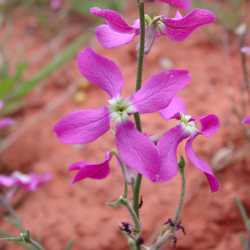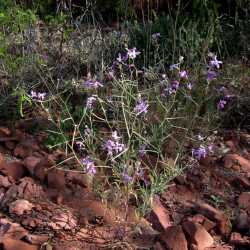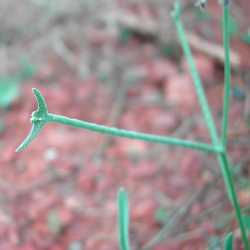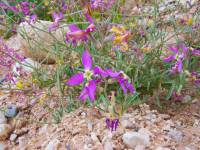Annuals; sparsely to moderately pubescent, (glandular papillae present or not). Stems erect or ascending to decumbent, (1-)1.5-5(-6) dm, pubescent, (glandular or not). Basal leaves not forming vegetative rosettes. Cauline leaves: petiole to 2 cm or (distal) sessile; blade linear-lanceolate to lanceolate or oblanceolate, (2-)3.5-8(-11) cm × 2-10(-20) mm (smaller distally), base attenuate to cuneate, margins usually pinnatisect to sinuate or dentate, rarely entire or subentire. Fruiting pedicels divaricate to divaricate-ascending, straight, (0.5-) 1-2(-3) mm, nearly as thick as fruit. Flowers: sepals narrowly oblong, (7-)8-11(-12.5) × 1-2 mm; petals usually purple, pink, yellow, or brown, rarely white, oblong to linear-lanceolate, (15-)18-23(-27) × 2-4(-5) mm, claw 7-13 mm, (margin crisped), apex subacute to obtuse; filaments 4-6 mm; anthers 2.5-3.5 mm. Fruits ascending to divaricate or, rarely, descending, straight, terete, (2.5-)4-8.5(-10) cm × 1-2 mm; valves pubescent, (often glandular); style obsolete to 3 mm; stigma horns 2, straight or curved upward, sometimes reflexed, 2-8 (-12) mm. Seeds suborbicular to oblong or ovate, 1-2 × 0.8-1.2 mm; wing 0.1-0.2 mm. 2n = 14.
Flowering Mar-Jun. Roadsides, disturbed areas, waste grounds, fields; 700-1300 m; introduced; Alta., Ont., Sask.; Ariz., Calif., Tex.; Europe; c, w Asia; n Africa; introduced also in Australia.
Matthiola longipetala is sporadically naturalized in North America and Australia.
Duration: Annual
Nativity: Non-Native
Lifeform: Forb/Herb
General: Small, erect to decumbent herbaceous shrubs, glabrous to pubescent, stems grayish-green, not arising from a basal rosette.
Leaves: Linear lanceolate, pediceled to sessile, 3.5-8 cm long, tending to concentrate towards the base of the plant, with flowering stalks arising above the leaves at the base, leaves becoming reduced as one moves up the stalk.
Flowers: Most often pink, but can purple, brown, yellow, or white, pin-wheeled in shape, with 4 free petals, sometimes reflexed or slightly whorled, white at the centers. Claw 7-15 mm, petal margins crisped. Sepals narrowly oblong, Fruiting pedicels have a distinct half-moon shape with 2 small, raised nodes in the center.
Fruits: Ascending, (occasionally descending),straight, terete, with glandular, pubescent valves, style singular and very small (to 3 mm), with 2 straight, curved, or reflexed stigma horns.
Ecology: Found in disturbed areas, on roadsides, waste sites, and fields, from 2,000-4,500 ft (610-1372 m); flowers March-June.
Ethnobotany: Unknown
Etymology: Matthiola is named after Pietro (Pier) Andrea Gregorio Mattioli (1500--1577), an Italian physician and naturalist. He received an M.D. from the University of Padua in 1523 and was physician to Maximilian II and Ferdinand I of Austria, while longipetala means with long petals.
Synonyms: Cheiranthus longipetalus, Matthiola aspera, Matthiola aspera var. aspera, Matthiola kralikii, Matthiola longipetala var. oxyceras, M. oxyceras
Editor: LCrumbacher, 2011







